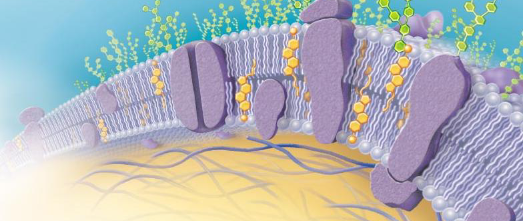-
What are the important cell membrane structures?
phospholipid bilayer, membrane proteins, and membrane carbohydrates
-
What is the phospholipid bilayer?
- continuous layer around the cell
- barrier to water soluble substances (not to lipid soluble molecules and small molecules like oxygen and CO2)
-
What are the membrane proteins?
transport proteins, receptor proteins, enzymes, joining proteins, and identifying proteins
-
What is an example of a identifying protein (membrane protein)?
major histocompatibility complex (MHC) proteins
- on the surface of all cells except red blood cells
- identify the cell as part of the body (not foreign)
-
What do joining proteins do (membrane protein)? What are the two types?
- anchor cell membrane to cytoskeleton or an adjacent cell
two types:
- junctional proteins between cells (desmosomes, tight junctions, gap junctions)
- extracellular fibers (usually glycoproteins)
-
What do enzymes (membrane protein) do for the cell membrane?
control chemical reactions on outer or inner surface
Examples:
- acetylcholinesterase
- Na+/K+- ATPase - all cells have these
-
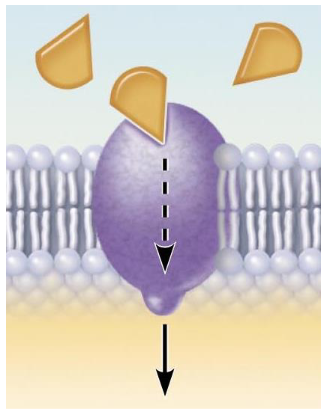
What do receptor proteins (membrane protein) do?
can bind specific extracellular molecules (= ligands) like hormones and neurotransmitters (nt)
example: glucose uptake (by skeletal muscle cells or adipose tissue):
- insulin binds to receptor on skeletal muscle or adipose tissue
- triggers movement of more glucose transporters to cell membrane
- ⇑ glucose movement from blood into cells
-
What are the two types of transport proteins (membrane proteins)?
channels and carrier proteins
-
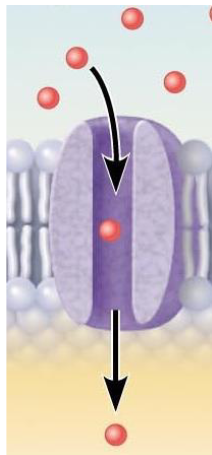
What are transport protein channels and what do they do?
- form pore in membrane through which selected ions/molecules can move freely
- selectively permit channel-mediated facilitated diffusion of water & specific ions
- Can be: gated (can open or close – when signaled) or non-gated (leakage channels, always open)
-
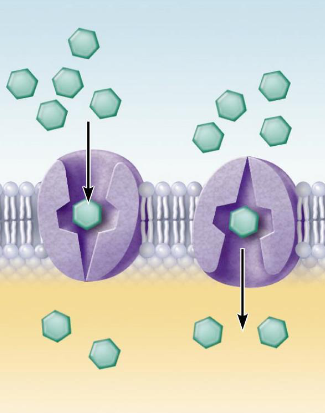
What do transport protein carrier proteins do?
- bind to solute (ion/molecule) and help carry it across membrane
- allow protein carrier-mediated facilitated diffusion OR active transport
- e.g. glucose transporters
-
What does homeostasis rely on that involves the cell membrane?
the ability of cells to maintain the composition of the intracellular (ICF) and extracellular (ECF) fluids and to move solutes and/or solvents across the cell membrane
-
What is a solute?
substance dissolved in a solution
-
What is a solvent?
substance solute is dissolved in (e.g. water, some lipids, alcohol)
-
What are the 2 types of transport in the cell membrane?
passive and active transport
-
What are the defining characteristics of passive transport?
no energy required (no ATP)
movement from a high to low concentration (i.e. down its concentration gradient)
the greater the difference in concentration = the more molecules want to move
-
What are the 5 different types of passive transport?
Simple diffusion (solute movement), channel-mediated facilitated diffusion (solute movement), carrier-mediated facilitated diffusion (solute movement), osmosis (solvent movement), and Bulk flow
-
What is simple diffusion?
- passive transport, solute movement
- solute diffuses directly through cell membrane bilayer ∴ small and lipid soluble molecules (O2, CO2, etc.)
-
What is Channel-mediated facilitated diffusion?
- passive transport, solute movement
- ions diffuse through membrane via protein channels – the solute does not bind to the protein, but moves freely through the opening created by the channel
-
What is Carrier-mediated facilitated diffusion?
- passive transport, solute movement
- large, charged or water soluble molecules diffuse across membrane using a specific carrier protein – must bind to protein to be transported
- e.g. glucose movement into liver or skeletal muscle
-
What is osmosis in terms of passive membrane transport?
- solvent movement passive transport
- movement of H2O across a semipermeable membrane (permeable to H2O) due to [H2O] difference (H2O moves down its concentration gradient) via pores (channels) or across the membrane bilayer
-
What is osmotic pressure?
- the pressure required to prevent the movement of water across a semipermeable membrane due to osmosis
-
What is osmotic pressure determined by?
- the concentration of solutes in a solution.
- Pure water has an osmotic pressure of 0, and the greater the solute concentration, the higher the osmotic pressure will be
-
How is osmotic pressure used to measure solute concentration in a solution?
- high osmotic pressure = high [solute]/low [H2O]
- low osmotic pressure = low [solute]/high [H2O]
-
What is tonicity?
- response of a cell immersed in a solution
- depends on solute concentration (and permeability of the cell membrane to the solute)
-
What are the classifications of tonicity?
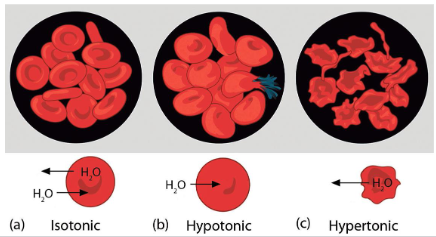
hypotonic solution, hypertonic solution, and isotonic solution
-
What is a hypotonic solution?
ECF has lower osmotic pressure (higher concentration of water) than ICF (cytosol)
cell swells (takes in water)
-
What is lysis?
- the burst/rupture of a cell, caused by swelling in a hypotonic solution
- rupture of a red blood cell (RBC) = hemolysis
-
What is a hypertonic solution?
ECF has higher osmotic pressure (lower concentration of water) than ICF (cytosol)
cell shrinks (loses H2O)
-
What is an isotonic solution?
ECF and ICF have equal osmotic pressures
cell neither swells nor shrinks
-
What is a use of tonicity?
injecting 10% sucrose solution (hypertonic) will move water to blood stream
e.g. use to reduce brain edema (swelling)
-
What is the role of osmosis in regulation of solute concentration?
- Concentration of solutes in body fluids must be maintained within narrow limits or cells will die
-
What are the major body fluids?
- extracellular fluids (ECFs): blood plasma, interstitial fluid (ISF)
- intracellular fluid (ICF)
-
What happens (with regards to osmosis) when the body looses H2O (like through sweating)?
- the concentration of the blood increases, and therefore the osmotic pressure of the blood increases
-
What happens when the osmotic pressure of blood increases?
- fluid moves from the tissues into blood (dehydration of tissues)
- the response will include thirst and a decrease in renal H2O loss which leads to decreased urine production
-
What is bulk flow?
- passive membrane transport
- movement of fluids (and solutes) due to a pressure gradient (moves from high pressure to low pressure)
-
What is hydrostatic pressure?
- the pressure of a fluid pressing against a surface
- examples of surfaces: cell membrane, blood vessel wall (blood pressure)
-
What happens in capillary when blood has higher pressure than ISF?
- fluid flows out of the capillary (= filtration)
- If ISF has higher pressure than blood, fluid flows from ISF into the capillary (= absorption)
-
What is an active cell membrane process? What are the types?
- Require energy (ATP) to move ions/molecules against their concentration gradient
- types: active transport and vesicular transport
-
What is active transport?
- a cell membrane active process
- substances move against concentration gradient (from low to high)
- always protein carrier-mediated
-
What are the types of active transport?
Primary (1°) Active Transport and Secondary (2°) Active Transport
-
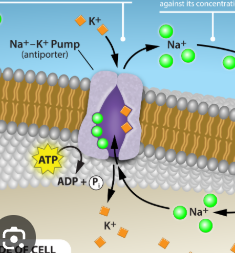
What is Primary (1°) Active Transport?
- a type of active transport
- molecular pumps - ATP breakdown is directly part of transport process
- e.g. Na+/K+-ATPase Pump ---> 3 Na+ out of cell and 2 K+ in per ATP
-
What is Secondary (2°) Active Transport?
- a type of active transport
- cotransport (use of ATP is indirect)
-
What would happen in Secondary (2°) Active Transport with glucose absorption by enterocytes (cells lining the lumen of the small intestine)?
- a Na+ gradient is established by Na+/K+-ATPase (ATP use step)
- glucose & Na+ both must bind to the carrier protein and are cotransported into the cell ⇒ Na+ moving down its concentration gradient drives in glucose against its concentration gradient (transport step)
-
What is vesicular transport? What are its types?
- a type of active process
- substance is surrounded by a membrane within the cell (vesicle)
- types: endocytosis (movement into a cell) and exocytosis (movement out of a cell)
-
What is the cycle for primary active transport?
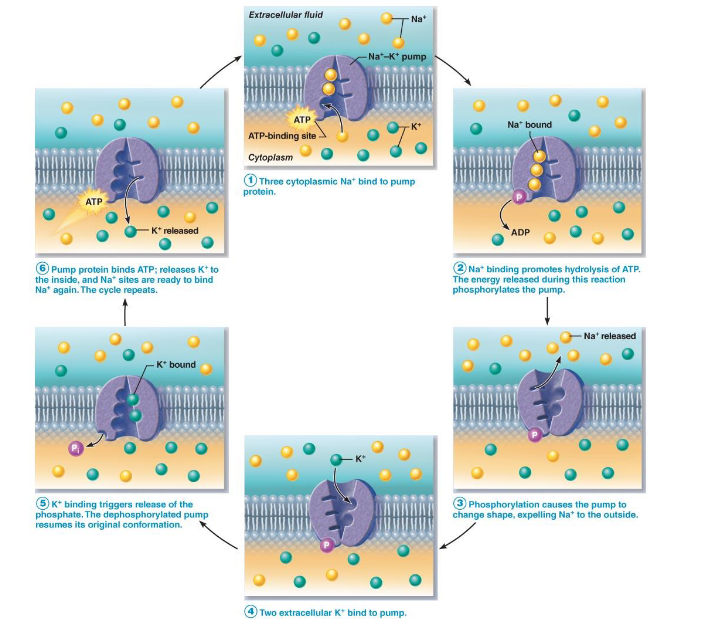
-
What are the types of endocytosis? What do they do?
- Phagocytosis: large items into cell (like bacteria), like the cell eating
- Pinocytosis: fluids (+ dissolved substances), like cell drinking
-
What is exocytosis?
- type of vesicular transport
- the process of moving large molecules out of the cell, which are vesicles containing hormones, enzymes, neurotransmitters, etc
- the vesicles fuse with cell membrane releasing contents into ECF (triggered by the rise in cytosolic calcium ions Ca++)
